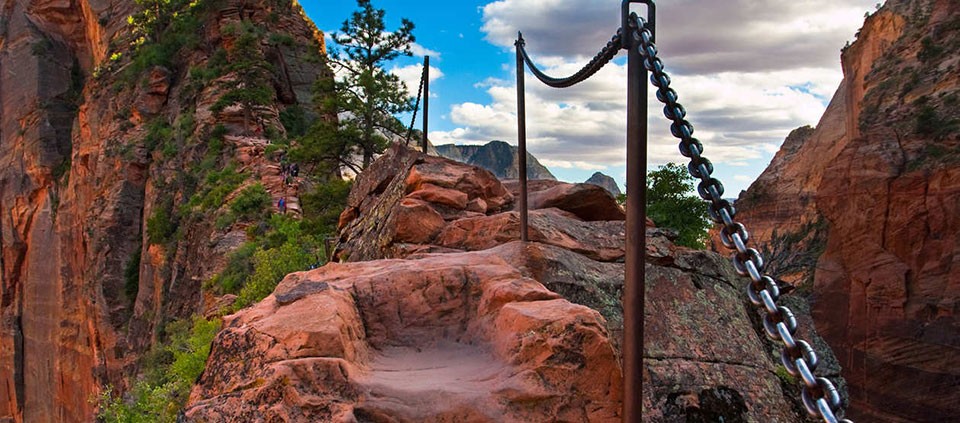Walking the Precipice Between Fear and Presence

by Janet Arnold-Grych
The dark thought, the shame, the malice.
meet them at the door laughing and invite them in.
Be grateful for whatever comes.
because each has been sent
as a guide from beyond.
—Rumi (excerpted from “The Guest House”)
Great yogis, mystics, scholars, and my mother-in-law have all espoused the importance of being present, of fully inhabiting our experiences so we can use them to feed our growth. That plan works when we see experiences as joyous, hopeful—or even, like bad-tasting medicine, something yucky that we know will ultimately do us good.
Fear, however, is a tricky emotion. Who wants to stand and hold that, even if it's wrapped around a gift? Our millennia-old genes are programmed, in fact, to shout “Run! Hide!” in response to scary situations.
How can we be with fear and keep our eyes open, especially if we really do want to see what’s on the other side of that fear? I thought about this question after I’d chosen not to look up.
I like to tell people I’m a hiker, though I’ve been on only one true, extended hike (which I really enjoyed, so I figure that buys me some "trail cred"). When my husband and I visited his longtime friend Bob out West, we immediately accepted Bob’s invitation to hike a treacherous trail in a local national park (after all, we’re hikers).
The first part of the climb was filled with arduous switchbacks—a portion we would later label as “cake.” Then came part two with an ascent both challenging and uneven. To assist, the Park Service has installed a post-and-chain-link “rope” that allows you to pull yourself up, while simultaneously questioning if a swinging chain a thousand feet in the air can truly be considered a safety feature.
Thankfully, Bob—or Crazy Bob, as I came to call him—had climbed this trail before. That’s why, for long segments of time, I focused only on his shoes, watching for the toeholds he chose and ignoring the vast and beautiful space all around me. A small voice inside me truly wanted to look up, to look out and see the view, but I was too scared.
It was good, even appropriate, to have some fear, but it overrode my ability to experience what was also beautiful in that moment. Whether it's hiking a mountain or standing in front of a room to deliver a speech or giving rec league kickball a go, most of us have been in that place of straddling fear and presence, and many of strive to move out of that place as quickly as possible. Fear, however, is spring-loaded. The more we simply push it down, the more likely it is to pop right back up.
"In ignoring fear, we get farther away from integrating it," says Aruni Nan Futuronsky, Kripalu Yoga teacher and life coach. “I have a little kid in me that had a lot to be afraid of. Trying to just shut her up and move forward is mean. I want to connect, acknowledge, show up, and outlive those feelings of fear. I want to ride the wave.”
Fear can be the byproduct of a well-worn, inaccurate narrative that cautions, “Hey, you’re really not that capable, or interesting, or skilled. You’re actually an imposter and sure to be found out.” If we notice our fear but don't allow it to become the endpoint of our narrative, the narrative changes. It's getting a toehold in something other than the fear that allows us to peer over the top. It’s noticing what is happening as separate from the meaning we're attaching to it.
“The other day, for example, I was driving home late on the turnpike,” Aruni shares. “I felt a memory of fear rise up that said things weren't okay. Of course, my car has lights and gas. Of course, I can go faster or slower. I'm equipped and I'm able. I wasn't rejecting the fear, but I was outliving it, and things were okay."
Aruni notes that journaling can be a great way to identify patterns that arise around fear. We can play with responses to prompts like, "I get afraid when …" or "The feelings that arise are …" The objective is not to fix anything, just to hold it and examine it.
To move beyond fear, we need to find ways to explore and honor it, without being restrained by it. That simple act of acceptance can loosen fear’s grip. "Life gives me exactly what is needed to trigger that which is ready to be released,” says Aruni. “
Reframing fear can expand the space that also lets in aliveness, engagement and presence. And, curiously, we need not hold only one emotion. Welcoming all of those feelings, as Rumi suggests, helps us to loosen our breath—and even to look up.
Find out about upcoming programs with Aruni Nan Futuronsky at Kripalu.
Janet Arnold-Grych is a yoga teacher and writer whose work has been published in Elephant Journal, Huffington Post, Third Coast Digest, and other outlets.
© Kripalu Center for Yoga & Health. All rights reserved. To request permission to reprint, please email editor@kripalu.org.